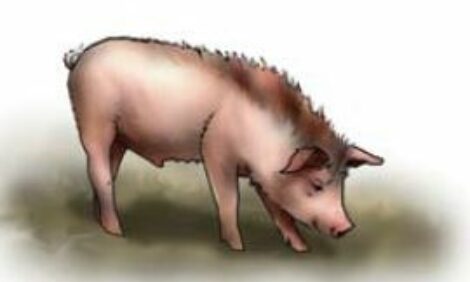



Krškopolje
The Krškopolje pig or black-belted pig is the only preserved Slovenian indigenous pig breed. It originates from the south-east part of Dolenjska region, the area of Krško-Brežiško field and in the foothills of Gorjanci hills and is well-adapted to low-feed growth. It has large appetite, great ability to produce fat, good meat quality, good resistance, good maternal traits, and moderate fertility traits. The breed was prosecuted in the past and only the most persistent breeders are deserving that breed still exists.
The first known written record dates from the middle of 19th century. It was reported that pigs in the Krško field were uniform in proportions, colour, and also in other traits, and they are distinguishable from other breeds. However, many breeders from that time mixed and crossed the Krškopolje pig with the Yorkshire, and so it declined. In the rural survey from the year 1938, Oblak pointed out that original Krškopolje pig could be found only in the most rural villages.
The Krškopolje pig is middle to large breed. It has a characteristic continuous white belt over its shoulder; its forelegs are white, and the nose top should be white as well. The rest of the body is black. The head is medium sized, with looped ears of medium length, and a slightly dished face. The body is wide and not particularly deep, with a long, wide, straight back. The Krškopolje’s shoulders are strong and medium width; hams are broad, full, and long. Coat is strong and strait, and dark over pigmented parts of the body.
Adult sows have body length between 155-175 cm, wither height between 80-85 cm, and rump height between 85-90 cm. On their first litter, Krškopolje sows have 8.2 live piglets, and can go on to have 10.4 piglets on average during their breeding life. Fatteners are capable to gain 1 kg/day, however the feed composition is rarely ideal, and this could be higher under more controlled conditions. Slaughter yield is near 80%, and the lean meat content is between 40-45%.
After WWII, many studies in the fertility, fattening, and make-up of Krškopolje pig were performed (Eiselt and Ferjan, 1972). On the other hand, breeders were left to themselves without any professional support at breeding and rearing and the breed was put to the list of endangered Slovenian animals in the year 1991. The herdbook was established in the year 1992, three family farms were included in gene bank and they started with pedigree and performance recording. After the year 2003, the interest of raising the Krškopolje pigs has increased. Consequently, the breeding herd in year 2011 consisted of 124 sows and 49 boars. However, breeders have on average only 1 to 2 sows. Over the last years, between 40 and 70 buyers purchase around 200 pigs for fattening from breeding farms. The breed is included in the breeding program for pigs SloHibrid, which is run by the Chamber for Agriculture and Forestry of Slovenia.






